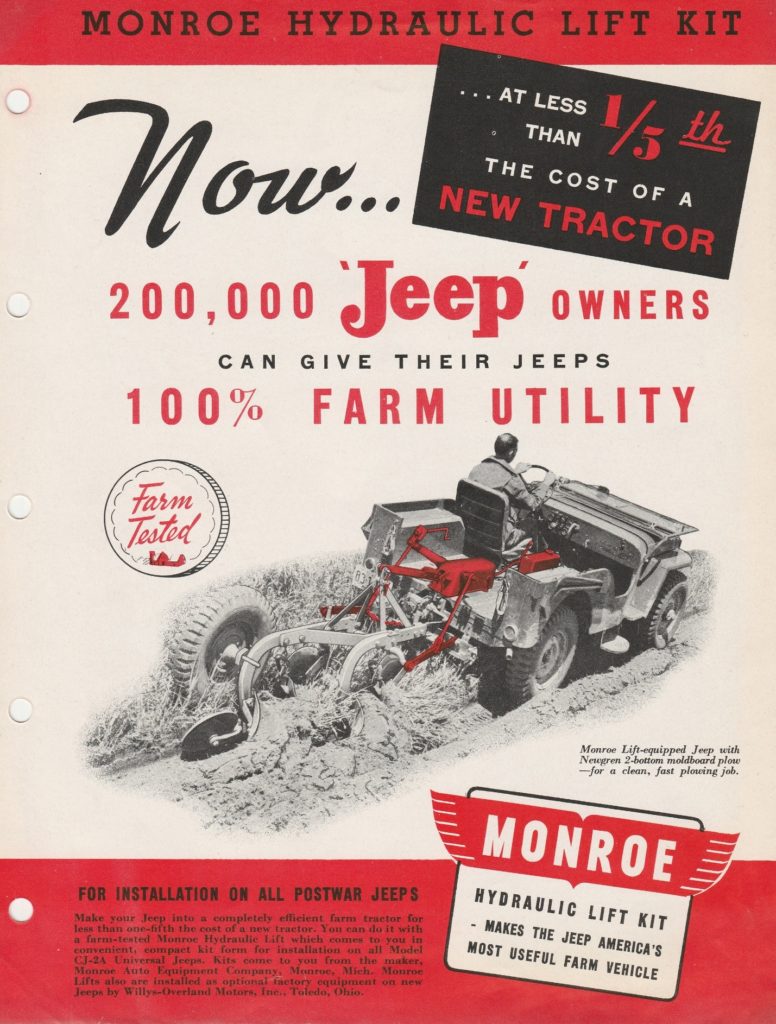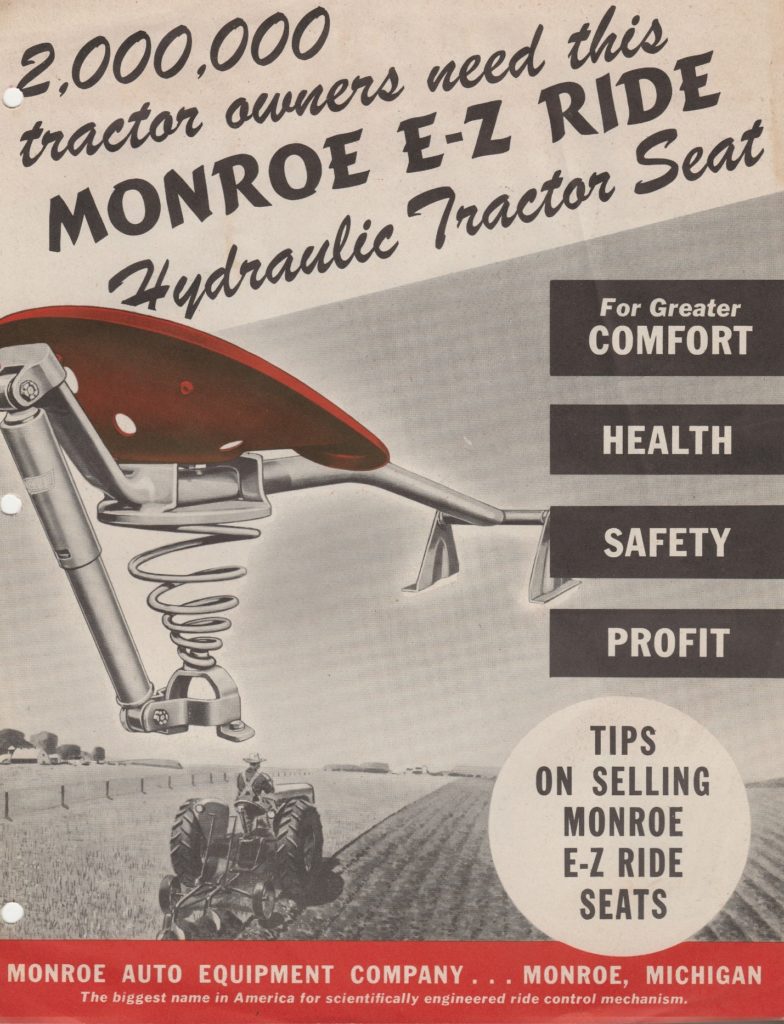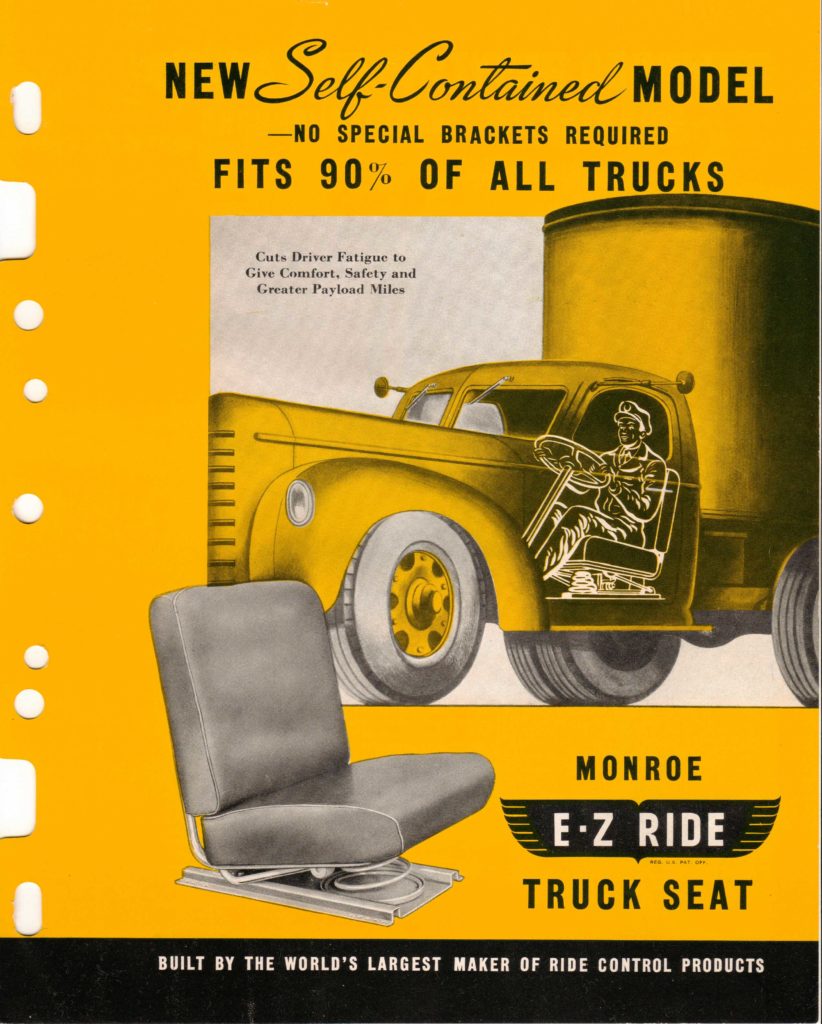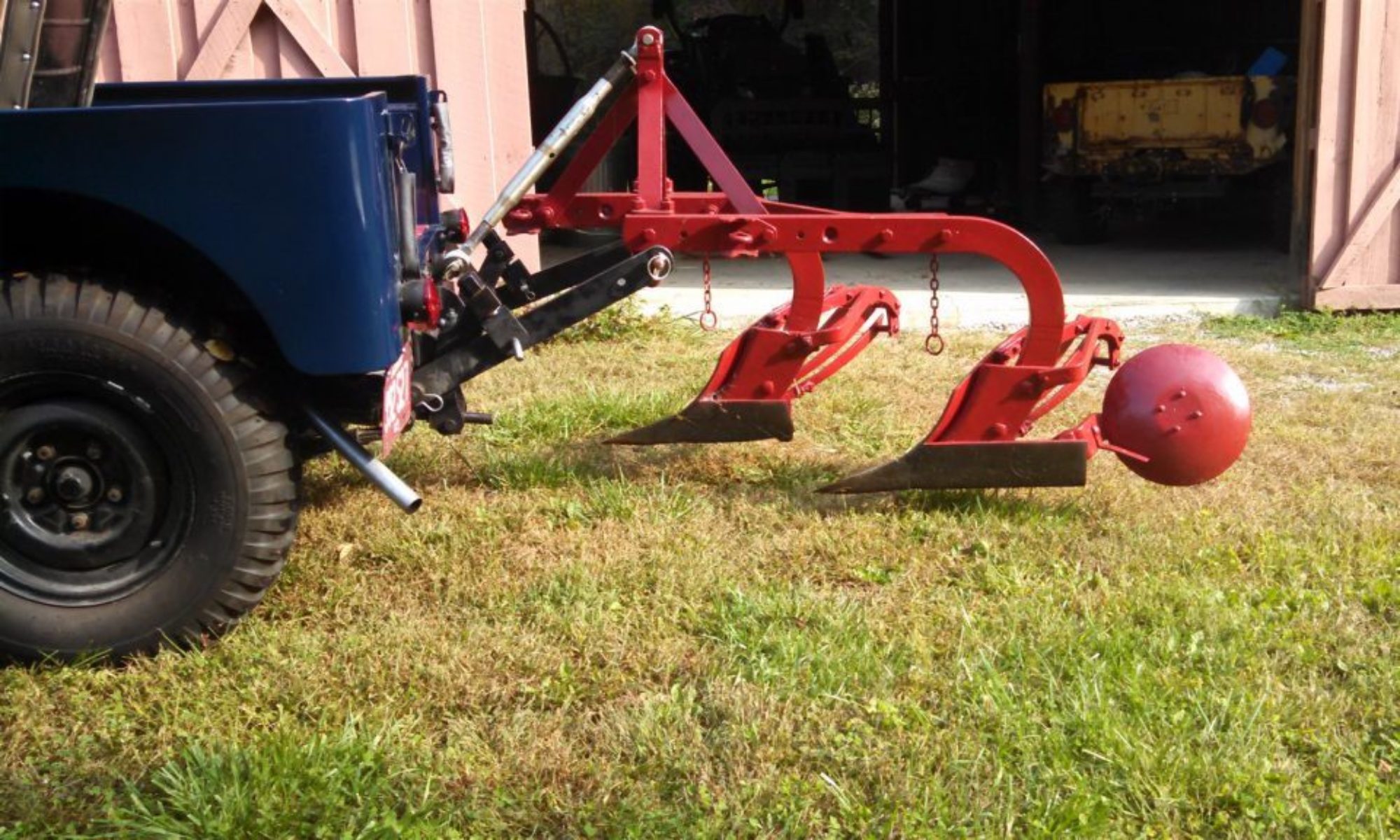by Clint Dixon
Chapter 1
Soon after they founded the Newgren Company, George Newlin and Henry Green found competition in the market quickly increasing as another company entered into the business of outfitting Jeeps with hydraulic lift systems. This time, it was not a newly formed company, but a long established family owned business – the Monroe Auto Equipment Company of Monroe, Michigan. And, they brought to the table a new three-point hitch of their own design.
The Monroe Auto Equipment Company had evolved earlier in the century from the Brisk Blast Company. In 1918, Charles S. McIntyre Sr., an established dealer of Dodge motorcars, partnered with Brisk’s President August Meyer to become Vice President of the company. The core of Brisk’s business at the time was manufacturing tire pumps. The company quickly expanded, started producing shock eliminators in 1926, and settled upon its iconic name in 1927. By 1937 Charles’s eldest son Brouwer D. McIntyre was presiding over the company accompanied by his two brothers; Charles Jr. and William.[1] They had by now expanded their product line to include truck and tractor steering components and seats. During the war, their efforts concentrated on producing seats for tanks, projectiles, and hydraulics for long-range bombers.[2]
One name commonly recognized by Jeep enthusiasts is that of Ivan N. Schatzka. Before his 26-year tenure with Willys, and its resulting offspring, Mr. Schatzka worked as a senior project engineer at Monroe from 1946 to 1955. Early on during this timeframe he, along with chief engineer Charles Joseph Smith and William Esdale, began design and testing of the three-point hitch system that would eventually become known in most factory publications as the “Monroe Hydraulic Lift”.[3] ,[4]
Monroe had developed close relations with Willys-Overland Motors, Inc. years before the war. This relationship was strengthened further once Brouwer took a seat on the Willys board of directors. The Willys board had elected Mr. McIntyre along with Arthur J. Wieland on January 21, 1947.[5] Mr. Weiland was actively serving as Willys Vice President of Distribution at the time of the appointment.
By the summer of 1947 design and testing of the new Monroe Hydraulic Lift prototypes was nearing completion. Brouwer’s son, Charles S. McIntyre III (Chuck), joined the Monroe effort while on break between semesters at college. He traveled around the country helping to demonstrate the new lift system along with attached farm implements at scheduled events .The list of implements that they transported from show to show included plows, discs, and harrows, all having the specific purpose of tilling the soil to hopefully impress upon the buying public and members of the press the virtues of the new system. Among show locations, key demonstrations took place in Ohio, North Dakota, and Texas.[6]
Competitor’s lift systems, notably those from Love and Newgren, required somewhat specialized implements that differed from the emerging standards – namely those available from Ferguson and Dearborn. The 1949-1950 edition of the Red Tractor Book reported; “The first SAE specification for agricultural tractor drawbar location was adopted in 1917 shortly after the Society of Tractor Engineers amalgamated with the Society of Automobile Engineers. The standard, as revised in 1937, was adopted jointly by the American Society of Agricultural Engineers, and is accordingly published as SAE-ASAE Standard.” However it was not until March of 1959 that an ASAE standard specifically for hydraulic lift systems was approved and titled: Three-Point Free-Link Attachment for Hitching Implements to Agricultural Wheel Tractors.[7]
This lack of standardized parameters for hitch systems up through the 1950’s became most apparent in the functioning of the plow. Ferguson and Dearborn plows were designed to operate specifically with the Ferguson System first employed by Ford in 1939 on its new 9N model tractor. The geometry created by converging (semi-parallel) upper and lower links of the Ferguson System caused the plow, as well as some other implements, to have an 18-inch mast height. This 18-inch height would later become a key dimension in what was to become known as the “Category I” ASAE standard.[8]
Newgren and Love lift assemblies were designed to mount to the back of the Jeep completely below an open tailgate. Thus, the upper link point and the two lower link points did not fall at the corners of an equilateral triangle. The result was that they created a very squatty isosceles triangle with the upper link point forced to fall beneath the tailgate. This unique geometry was carried over in part to the layout of the upper hitch point and the two lower hitch points on the plow. This geometry resulted in a reduced mast height on the plows used by Love and Newgren when compared to those used with the Ford tractor.

The Love and Newgren lifts, by design, operated more efficiently at pulling equipment attached to them when those implements were designed with reduced mast heights. Newgren attacked this problem by engineering not only the plow but other key implements with shorter masts to their own specifications.
Monroe engineers designed their new lift system to benefit the farmer in such a way that he did not have to buy specialized implements with reduced mast heights. The Monroe Hydraulic Lift was designed with converging upper and lower links functioning in a working geometry not unlike that of the Ferguson System. This design allowed existing Ferguson implements already on the market to be used. Since Charles Sorensen had presided over Willys-Overland since 1944, and knowing that he had gained extensive experience with the Ford tractor and Ferguson System from his prior days as Henry Ford’s “right-hand man”, it is not a stretch of the imagination to consider that he may have had some influence upon the Monroe design.
The critical design feature that allowed Monroe’s new unit to operate with existing Ferguson implements was in their placement of the upper hitch point. This attachment point was positioned at the rear of a large clamshell shaped casting which served to house the hydraulic cylinder assembly, main shaft, center arm, and clevis arms. This entire unit occupied space within the cargo area of the Jeep, bolting to the floor and rear sill. Thus, the upper hitch point was much higher than that on the offerings from Love and Newgren. Because of the location of this assembly, the tailgate had to be removed from the vehicle when the assembly was in place. However only two hydraulic hoses, three cap screws, and two clevis pins needed to be removed in order to remove the clamshell assembly from the rear of the Jeep in order to free up the cargo bed and to reinstall the tailgate. Additionally, with the clevis arms now located in close proximity to the operator, from the driver’s seat one could conveniently reach the hand crank on the leveling link assembly in order to make side-to-side height adjustments to mounted implements, without stopping the vehicle.
The Monroe Lift differed from all other offerings available for the Jeep in all but one detail. The earliest hydraulic pump used by Monroe was a Pesco pump part #051012-023-01. Owners report this was the very same pump that Newgren had used previously. Later pumps changes slightly in their method of sealing.[9] This particular pump was directly driven off the front of the engine’s crankshaft. Monroe also offered an optional v-belt driven pump mounted to the cylinder head of the engine for Jeeps that were driving other equipment off of the crankshaft.


The Monroe control valve and reservoir tank assembly mounted in the Universal Jeep directly to the right of the driver’s seat, with the valve’s manual control lever and adjustable down pressure screw within easy reach of the operator. There was no provision for controlling the lift at the rear of the vehicle in contrast to that of the earlier Newgren. Check chains connected to the lower links allowed for limited side-to side following of implements. When an implement was raised to the transport position, the check chains became tight and prevented all side-to-side movement. A Newgren stabilizer kit was available to prevent all side-to-side sway of implements while in the ground engaged position if so desired.
Several of the Monroe Lift parts closely resemble those on the Ford and Ferguson tractors, enough to fool even seasoned tractor collectors. Some of the Monroe components were cast with letters “UT” in relief, within a rectangle with rounded corners, also in relief. It appears that these parts were produced by the Unitcast Corporation, Steel Casting Division, Toledo, Ohio. This same insignia has also been found to appear on some Dearborn parts. The Monroe parts are slightly smaller and lighter than their competition in almost every case. This is most notable in the lower links. These links are almost identical to those used by Ford and Ferguson except that they are much shorter at only 24-1/2 inches between center lines of the lower link spherical ball and the lower hitch spherical ball. This is in comparison to the 32-inch measurement on the Ford and Ferguson parts.
On October 26, 1947 the Chicago Daily Tribune reported; “Willys-Overland Motors distributors and dealers will serve as subdistributors on a nation-wide basis for Ferguson farm implements, Arthur J. Wieland, vice president in charge of distribution for the motor company announced today.” The newspaper went on to say that Mr. Wieland indicated that his company’s Universal Jeep would hereafter be factory equipped with a hydraulic lift unit designed to fit all Ferguson implements and that production on the lift was due to begin in December at the Monroe Auto Equipment Company. The official company announcement in a November article in WO Sales News expanded upon this report.[10]
Early photos and sales literature from Monroe do indeed clearly show Ferguson plows in use on the Universal Jeep. This would soon change however.
[1] Monroe History, http://www.monroe.com/downloads/history/21430_Monroe_100thTimeline_Poster_r3.pdf
[2] Jerry Wittkop, Curator of MAECO Display at Monroe County Historical Museum and retired SAE Engineer MAECO, personal correspondence
[3] Toledo Blade, Nickname was tribute to engineer’s knowledge, April 7, 1990
[4] Frederic L. Coldwell, Preproduction Civilian Jeeps, Dedication, Vintimage Inc., 2001, page xi
[5] The New York Times, Two Added to Willys Board, January 22, 1947
[6] C.S. (Chuck) McIntyre III, Retired President MAECO, personal correspondence
[7] Tractors and Their Power Units, Appendix I, John Wiley & Sons, Inc., New York – London, Second Edition March 1959, page 490
[8] Ibid, page 494
[9] Monroe Hydraulic Lift for the Universal Jeep, Installation On Jeep, page 6
[10] WO Sales News, New Monroe Hydraulic Lift Links Universal Jeep With Complete Line of Ferguson Farm Implements, Vol. II, No. II, November 1947

